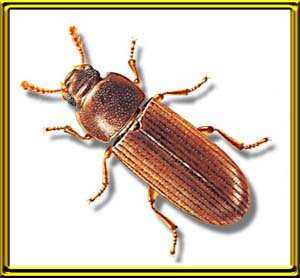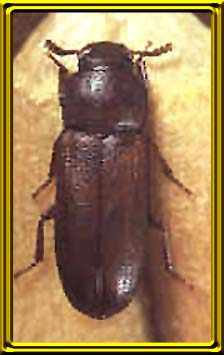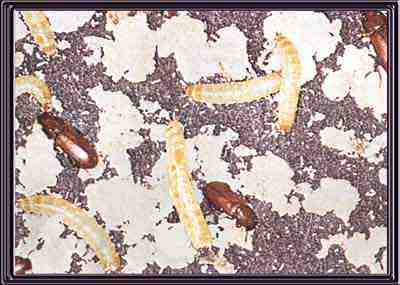
Tribolium
confusum
(Confused Flour Beetle)
(Confused Flour Beetle)

Tribolium
castaneum
(Rust Red Flour Beetle)
(Rust Red Flour Beetle)
Both the two above species are included on the same page because of the similarity of habitat and identification, the latter being the main problem. Hence both beetles are here for comparison.Both the confused and red flour beetles, known as "bran bugs," primarily attack milled grain products, such as flour and cereals. Both adults and larvae feed on grain dust and broken kernels, but not the undamaged whole grain kernels. These beetles often hitchhike into the home in infested flour and can multiply into large populations. Some survive on food accumulations in cabinet cracks, crevices, and furniture. Confused flour beetles are the most abundant and injurious insect pest of flour mills in the U.Kingdom, United States and Australia. They do not bite or sting humans or pets, spread disease, or feed on or damage the house or furniture.
In addition to milled grain products, beetle specimens have been found in barley, breakfast cereals, corn, cornmeal, crackers, flour, millet, oats, rice, rye, wheat and wheat bran, nutmeats, dried fruits, legume seeds, beans, milk chocolate, cottonseed, peas, powdered milk, sunflower seeds, vetch seeds, spices, herbarium and museum specimens, and even baits poisoned with arsenic's. It is particularly injurious in warehouses and in factories making starch products. Flour infested by the larvae has a greyish colour and a tendency to go mouldy.
Identification:
Both the confused and red flour beetles are similar in appearance. They measure about 1/10 to 1/8 inch long and are flat, shiny, reddish-brown, and elongated. Antennae segments of the confused flour beetle increase in size gradually from the base to the tip to form a club of four segments; in the red flour beetle, the last three segments at the tip of the antennae are abruptly larger than the preceding ones, forming a three-segmented club (this is evident looking at the two pictures above). Also, the confused flour beetle has a straight-sided thorax, while the thorax of the red flour beetle has curved sides. The sides of the confused flour beetle head capsule are notched at the eyes so that a visible ridge is present. This ridge is absent in the red flour beetle. When viewed from below. The eyes of the red flour beetle are separated by less than two eye diameters while those of the confused flour beetle are separated by more than three eye diameters. Red flour beetles fly but confused flour beetles do not.
Not usually able to chew through the outer coating of grain unless the moisture content is above 12 percent. However, other grain-feeding insects and mechanical harvesting injury provide a source of cracked kernels and dust food for them. The adults have glands on the abdomen and thorax which release a pungent gas when the insects are irritated. This, in turn, may produce a very undesirable odour in the grain. Contamination also occurs from the accumulation of dead bodies and waste products.
The eggs, larvae, and pupae are similar in both beetles. Eggs are whitish or colourless and microscopic in size, with food particles adhering to the sticky surface. Brown-headed larvae are cream to yellow, slender, and wiry, reaching a length of 1/4 inch (see picture below of beetles and larvae in flour). Larvae have six legs and two-pointed or forked projections at the last rear body segment. Pupae are white to light brown.
Life Cycle:
This is a very prolific species. Both beetles breed in damaged grain, grain dust, high-moisture wheat kernels, flour, etc. Female beetles each lay 300 to 400 eggs in flour or other foods during a period of five to eight months (two to three eggs per day). Within 5 to 12 days, these eggs hatch into slender, cylindrical, white larvae tinged with yellow. The length of the larval period varies from 22 to more than 100 days; the pupal period is about 8 days. Fully grown larvae transform to naked pupae, and in a week adults emerge. The life cycle requires 7 to 12 weeks, with adults living for 3 years or more. Ideally this type of beetle prefers temperatures of ca. 30°C and will not develop or breed at temperatures lower than 18°C.
Treatment:
Usually the most simple and effective control measure is to locate the source of infestation and quickly get rid of it. Dispose of heavily infested foods in wrapped, heavy plastic bags or in sealed containers and leave for garbage disposal service. If you detect these beetles early, disposal alone may solve the problem.
Careful sanitation is the best method to avoid any stored-product pests. After removing all food, food packages, utensils, dishes, etc. from the cupboard, shelves, or storage area, use a strong suction vacuum cleaner with proper attachments to clean all spilled foods (flour,rice, toaster crumbs, bits of pet food, raisins, etc.) from the cracks and crevices, behind, under, and in appliances and furniture. Scrub with soap and hot water. After shelves are thoroughly dry, cover with clean, fresh paper or foil before replacing with food (which is free from infestation) or cooking utensils.
In the case of industrial problems e.g. food factories, grain silos, bulk flour stores etc., as well as carrying out the procedures above, which should be an on-going task anyway, fumigation may have to be considered. This can be a costly procedure, but if the calculations show that it is cheaper to fumigate and still be able to use the grain after screening, rather than just throw the whole lot away, which, let's face it, is a waste, then it could be the way to go.
Managers should be aware of the hidden places which are not always cleaned or serviced such as, hard to get at parts of machinary, if there are augers in use there could well be a build up in the boxing around the auger itself, in fact any dead space which can be quite easily forgotten about is a prime target for this type of pest and once they get a hold there is a lot of money involved.
Make sure that your pest controller is doing their job correctly, and not just wandering on site, checking a few rodent boxes and wandering off site again.
Ideally you may need a consultant like myself to do a half yearly inspection. That way you will get an independant assessment of the site as it stands at that point in time.
